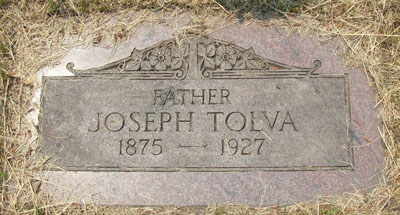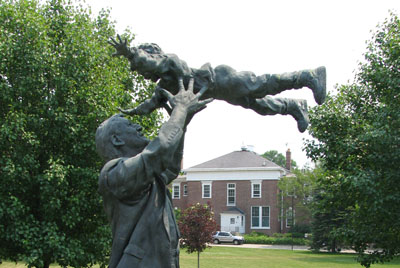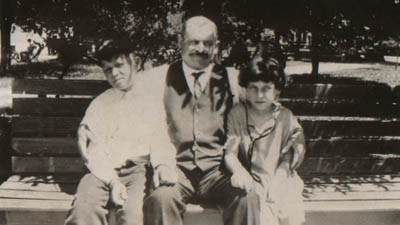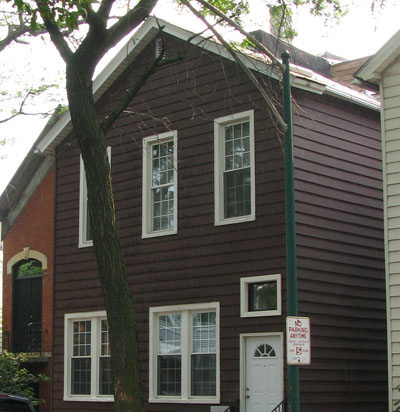Of orphans, the dead, and a house on a street that does not exist
Last weekend the boys and I set off on the last major pre-Italy fact-gathering adventure. Actually it was kinda morbid or, at least, odd for a five- and three-year-old. The goal was to visit my great-grandparents’ residence in Little Italy, the cemetery where they are buried, and the orphanage where my grandfather grew up. Why? Not entirely sure. Not a lot of facts to be gathered at these places frankly. I guess I just had to see.
We started in the massive, mostly-Italian cemetery of Our Lady of Mount Carmel. It is a Roman phonebook written in weathered stone.
We hunted around the graves with a crappy map. It was sweltering. And we were being pummeled by sex-crazed cicadas. But the boys were troopers. Nathan said “So, Dad. Everybody’s dead here?”
“Yes, all dead.”
“Why are they in the ground?”
Didn’t have a great answer for that one.
We got the map in the sprawling mausoleum which really freaked out the boys. Except occasionally for soft strains of angelic choirs coming from somewhere it was supernaturally quite — a situation my children have never experienced. Also the smell. Not quite rancid, but certainly not right. We got outta there quickly.

Back to the grave hunt. Basically Giuseppe Tolva doesn’t have a very elaborate grave, which is why it took us forever to find it. Most graves have upright markers and are visible from the cemetery roads, but his is flat with the ground all the way in the back of the vertical tombstones. I’d love to know who paid to inter him here and even more to know who put the artificial flower on the headstone. Interestingly there is no marker for his mistress nearby as we were led to believe. Just a joint grave for his two daughters.
The heat and bug assault was too much so we had to cut our hunt short for Grace, his wife. We decamped for Maryville Academy, the orphanage my grandfather grew up in when Grace died in childbirth with his brother. Frankly it was more depressing than the graveyard and even harder to grasp for my kids than the corpses in the ground.
“You mean the kids here have no parents? Why not?”
“Well some of them are dead and in the ground.”
The boys’ eyes enlarge to the size of silver dollars.

Actually Maryville isn’t an orphanage anymore. It serves physically, sexually and emotionally abused and neglected children. The old building, the beloved home of my grandfather (he maintained a relationship with the staff there all his life), is in sorry shape. It looks a bit like a dilapidated southern plantation house. The heat and cicadas made it feel all the more so. But still it felt like it could have been a good place for my grandfather. You’d not have been surprised to turn a corner and see this Maryville scene on a park bench. (Photo of my great-grandfather, great-uncle, and great-aunt circa 1920.)

Back into the city with two very tired boys. The heat-spawned rain was starting to fall as we headed into Little Italy. I had recently found Giuseppe’s World War I draft registration card which contained an important (and unknown) reference to his residence at the time: 908 Sholto. It was in his own scrawl so I figured I was reading it wrong. Never heard of such a street in Chicago. So I found a list of all the streets. Nope, no Sholto. Great, doesn’t exist. Or maybe the UIC construction in the 1960’s destroyed it? Turns out, the street had only been renamed. 908 Sholto is actually 908 S. Carpenter.

The kids had fallen asleep in the car by this point. It was pouring rain and I was prowling around the east edge of Little Italy looking a little suspicious. I’m pretty sure the home at 908 S. Carpenter is not the same one Giuseppe and Grazia lived in, but you never know. There are plenty of buildings that have stood that long. I have to believe they were crammed in there with other immigrants.
Yep, I guess I just had to see.
Hi, I’m John Tolva!
Mission Elapsed Time: 20:00:21:06:42:40
Recently this blog (and my Flickr account) turned 20 years old, forever in Internet years. I went back through it all, retracing digital footprints made on what feels like a different planet. Here are some highlights.
The Terror Tourist
A roughly monthly exploration of places in horror fiction — real or imagined, geographical or psychological — culled from The Heavy Leather Horror Show.
Subscribe to the podcast or the email newsletter or just read through the archives posted here.
The Ampcamper
How I hauled myself, two teens, an 80 lb dog, and a whole load of crap 4000+ miles across six states in twenty days using an electric vehicle. And survived to tell the tale.
Latest Photos
Marginalia
Stuff I’ve found interesting from around the web lately.
The Bureau of Linguistical Reality
Alicia Escott’s artistic thinking focuses on grappling with what it is to live a human life amid a moment that is profoundly rare in the geologic and ecologic history of the planet.
A Mystery in the Shape of a Book
On a gravel road outside of Cheyenne, Wyoming, I stood before a Little Free Library painted the colors of the Pride flag.
The Great Resegregation
The Trump administration’s attacks on DEI are aimed at reversing the civil-rights movement. Produced by ElevenLabs and News Over Audio (Noa) using AI narration. Listen to more stories on the Noa app.
Steal My Tesla
Don't waste any more time trying to sell your Tesla. We'll take it from here... Having difficulty selling your Tesla without all the hassle and negativity? Maybe its time to consider other options.
A Memorandum from the Newly Established Department of Grammar Efficiency
The federal Government is eliminating inefficient grammar. NO ONE understands how to properly use an em-dash or semicolon. Therefore, those types of punctuation are now ELIMINATED to protect hard-working American Citizens from further confusion. YOUR WELCOME.
What does Maga-land look like? Let me show you America’s unbeautiful suburban sprawl
In 1941 Dorothy Thompson, an American journalist who reported from Germany in the lead-up to the second world war, wrote an essay for Harper’s about the personality types most likely to be attracted to Nazism, headlined “Who Goes Nazi?” “Those who haven’t anything in them to tell them what
Bad at Goodbyes
On today’s show we learn about the Casey’s Larkspur, a critically endangered perennial herb native to the Kyrenia Mountains in northern Cyprus, an island in the east of the Mediterranean sea. Please find us on the web at Bad at Goodbyes and on instagram.
Yes, Paris has its own bicycle hearse and so does the United Kingdom
In the burgeoning bicycle city of Paris, France, those looking for a more gentle, environmentally friendly funeral service now have the option of a hearse powered by a cargo bike.
The Retro Subway Map That Design Nerds Love Makes a Comeback
When it comes to the New York City subway, what once was old is new again.
Bringing Italo Calvino’s Invisible Cities to life with AI
If you’ve ever read Italo Calvino’s Invisible Cities, it is not your typical book about urban landscapes.













